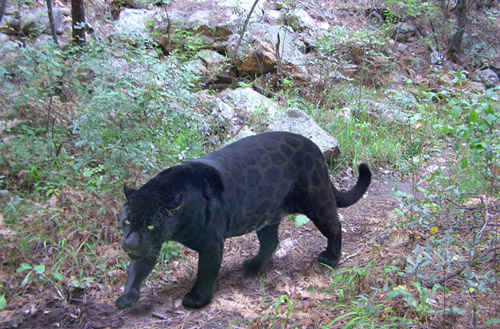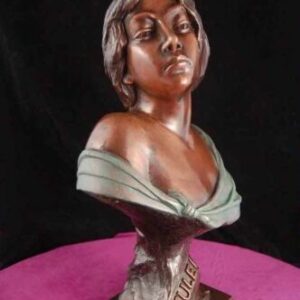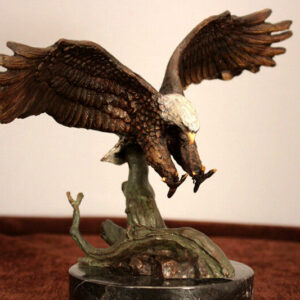Description
Beautiful Bronze Casting of a Melanistic Jaguar
Black Jaguar
Real Lost Wax Cast Bronze
Size: 16″ Long x 6″ High
The sleek power of this great cat is captured in Bronze to be enjoyed forever. People will refer to large black cats as Leopards, Panthers, Pumas, Jaguars not understanding the difference.
1st of all, there is no actual species called a panther, it’s just the name commonly used for melanistic Leopards – that is, Leopards with an excess of the dark pigment melanin, resulting in an almost entirely black coat (the markings still show up against the background in the right light). Leopards are found in Asia and Africa, with black individuals being the most common in the jungles of south-east Asia, perhaps because being black is less of a disadvantage here. Leopards are the fifth largest members of the cat family, weighing up to 200lb. They are excellent climbers and often take their kills into trees to keep them out of reach of other predators. In comparison with Jaguars, they are smaller and more lightly-built, with proportionally longer legs and tail and a narrower head. Their spots are arranged in small rings.

Some people also refer to melanistic Jaguars as Panthers, though the term originally applied only to black Leopards. Jaguars are the third largest cats, weighing a maximum of 350lb. They are found in South and Central America (recently a few individuals have even been caught on camera-traps in the extreme southern US). They love water and often hunt fish and turtles. Jaguars are bigger and more heavily-built than Leopards, with proportionately shorter legs and tail and a broader head. The spots are arranged in large, blotchy rosettes. The picture below is a black Jaguar.
Panthers should not be confused with Florida Panthers. This is the name commonly used for the pumas (also called Cougars, mountain lions, etc.) found in Florida. They are NOT black – Pumas are usually golden-brown, though they can range from nearly grey to nearly red. Melanism is possible in any species, but it is extremely rare in pumas. Pumas are found throughout North, Central and South America, though obviously only those in Florida are referred to as Florida Panthers. They are considered by some to be a unique and highly endangered subspecies, but recent genetic evidence suggests they may not be different enough from other pumas to be awarded subspecific status, which could have a negative effect on their conservation.
How Is It Made? |
|
The “Lost Wax” Process |
| What gives bronze art value beyond that of a “souvenir” that ends up in a closet? There are many reasons including cost of materials (bronze, silicone for molds, tools, ovens, etc.) The main reason is that there are very few people trained in the tedious process, practiced by the ancient Greeks and Romans.
Bronze sculpture is not easy to make and there are many time consuming, difficult steps involved. In a world of hi-tech mass production, bronze casting remains essentially unchanged. Each of our genuine bronze castings is in reality an “original” and the following explains why. These are the basic steps involved in creating a bronze Sculpture using the classic “cire perdue” (lost wax) process: |
|
| All bronze pieces are cast from a wax model regardless of the original material the model was sculpted. A silicone mold is made from the artist’s finished piece, and a hollow wax cast is drawn from this mold. The wax is then repaired, re-worked and finished to the sculptor’s specifications. Prior to creating a ceramic shell (explained below), vents are attached within the wax model. These vents are necessary in difficult areas where gas may accumulate such as hips, limbs, and neck. The vents allow the gas to escape when the molten bronze is poured and will prevent air pockets from forming and exploding the ceramic shell. The ceramic shell is one of the few materials the can withstand the heat of the molten metal.
When the wax cast is hardened and the vents are in place a ceramic shell is formed over the wax. This shell is made by dipping the wax into a slurry, coating it with sand, drying and repeating the process up to 14 times. A core consisting of plaster, ground brick and water is poured into the interior of the wax mold. After the ceramic shell and core have set, the mold is fired in an oven, the wax is melted and the ceramic shell is left intact. This process is known in French as “cire perdue” (lost wax). Molten bronze is now poured into the cavity left by the melted wax. When the bronze is cooled, the shell is chipped away using a hammer and chisel. The bronze must now be repaired and finished. This step is called “chasing” and it is a difficult process because the metal is involved. Any imperfection such as air pockets of pits must be brazed with bronze rod, as in welding. All seams and spurs must be removed by grinding, rasping and, finally, sanding. The next step is to chase or hammer the vents from the mold using special tools. The natural bronze has a dull finish. after final finishing, a patina is applied which may be left matte of polished. Chemicals, pigments, heat, safety equipment and a lot of experience are involved. In addition, since bronze comes in a variety of alloys, the patina requires different chemicals and techniques. When shopping for bronze art work, beware of terms such as “cold cast” or “bonded bronze.” These are misleading names given to plastic figurines. If you are unsure of the authenticity of an item that you see elsewhere, feel free to call us at 1-800-321-8618 for an honest and professional opinion. 800-321-8618 for questions or credit card..
______________________________________________________________________
Shipping Cost
Most of our items have FREE SHIPPING !
Shipping Time
Most orders within 24 hours or the same day !
Expedited Requests
We GLADLY EXPEDITE YOUR ORDER on request.
Insurance
FREE with all orders.
Professional Packaging
We package with great care! UPS has consistently rated us the shipper with the least damage claims in our region !
Customer Appreciation
Returning customers or if additional item wanted, call for special pricing and Free shipping.
Return Policy
Satisfaction guaranteed with a 30-Day exchange return policy.
|







Reviews
There are no reviews yet.